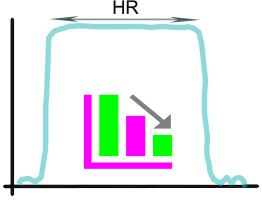With OTF Studio Software, you can tackle multilayer design challenges of any complexity. It offers powerful design and analysis tools, including synthesis algorithms enhanced with machine learning elements.
For trial versions, please reach out to our distribution partners.
Chirped mirror: Estimating the width of the high-reflection zone

Fig. 1. Schematic representation of a chirped mirror (read more here).
- A chirped mirror schematically shown in Fig. 1 can be used as a starting design for high reflectors or dispersive mirrors for ultrafast laser applications. Layer thicknesses of such mirrors deviate from the quarter-wave thicknesses. If $\lambda_0$ is the central wavelength of the HR zone and $\epsilon$ is a chirp parameter, then physical thicknesses of coating layers are evenly distributed between $0.25\cdot (1+\epsilon)\cdot\lambda_0/n_H,...,0.25\cdot (1-\epsilon)\cdot\lambda_0/n_L$ (thicknesses are decreasing as in Fig. 1) or between $0.25\cdot (1-\epsilon)\cdot\lambda_0/n_H,...,0.25\cdot (1+\epsilon)\cdot\lambda_0/n_L$ (thicknesses are increasing).
- The width of the HR zone $\Delta\lambda$ can be estimated as: $\Delta\lambda=\Delta\lambda_{QWM}+\epsilon\cdot\lambda_0$. Below you can estimate the HR zone and find a reasonable $\epsilon$ value for your design problem.
- The width of the HR zone is not dependent on the number of layers. Of course, if the number of layers is growing, the average reflectance over the HR zone is increasing.
Here you can estimate the width of HR zones of chirped mirrors (normal incidence) and plot the chiped mirror design structure. Input the parameters required for the calculations:
Chirp parameter ε (from -0.6 to +0.6): Central wavelength λ0 (100-25000 nm): nm Number of layer pairs (5-50): =
Refractive indices of layer materials: nH = nL =





















